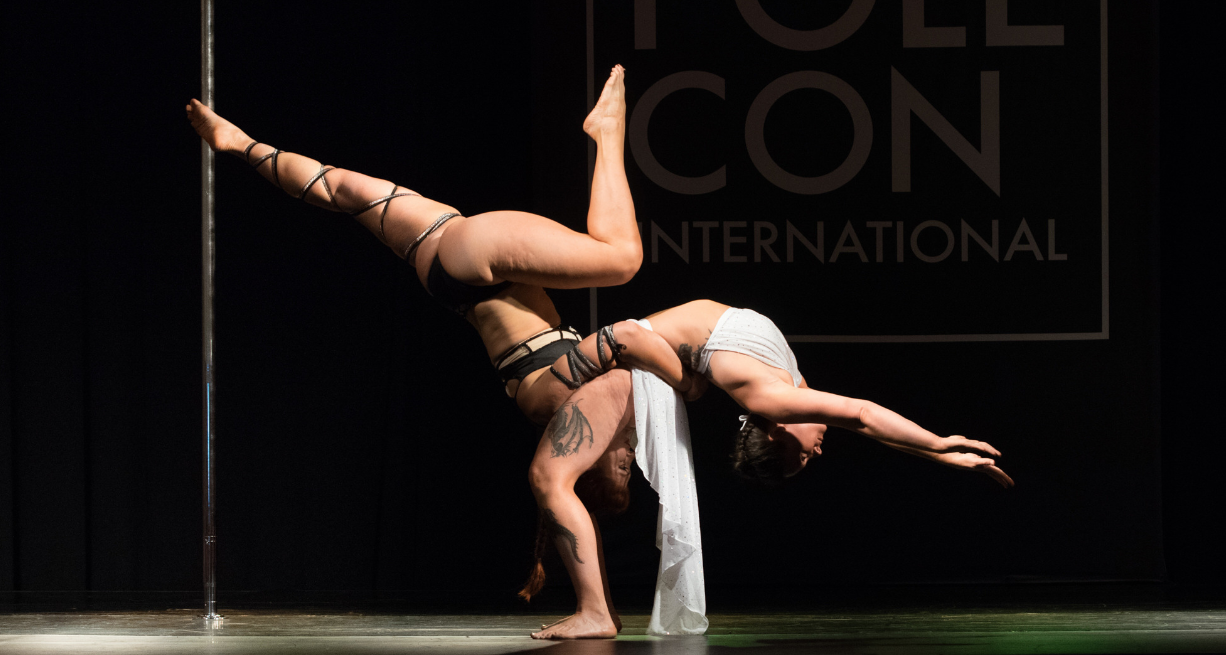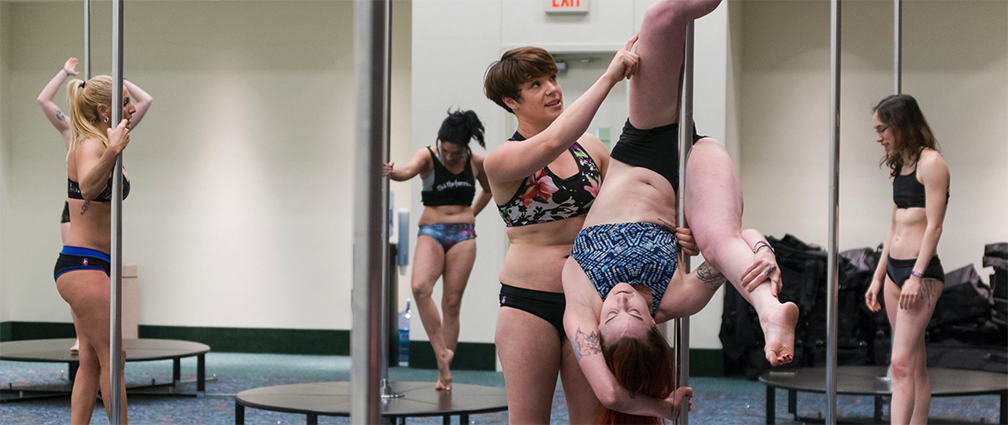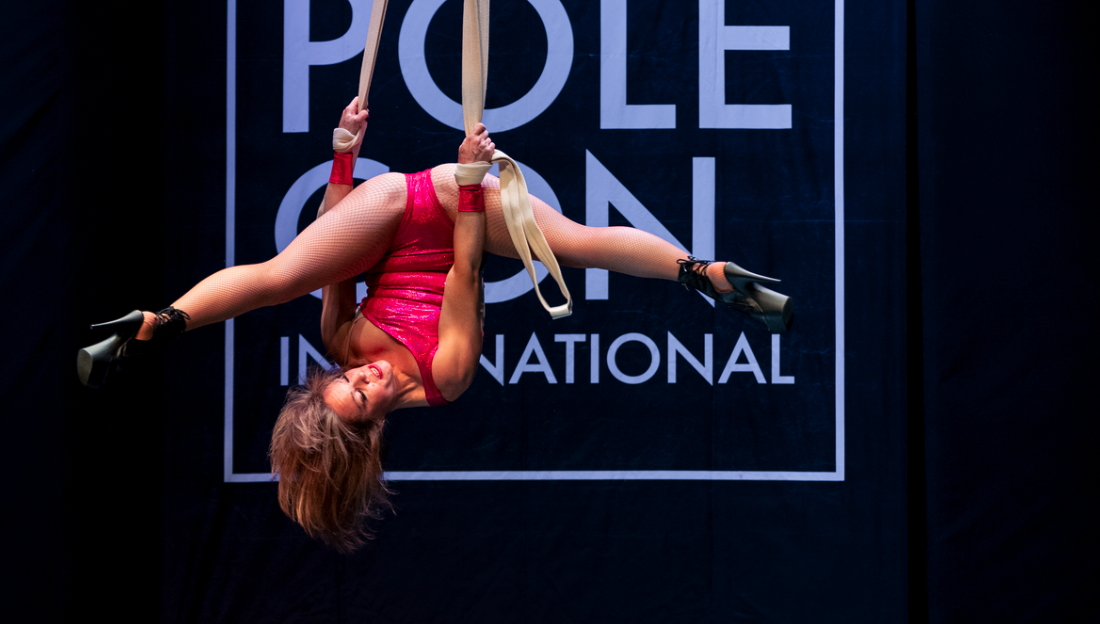I asked this a few weeks ago via social media and many people had some…

Proprioception (What is my body doing in space??)
Proprioception is a fancy way of saying how you understand where your body is in space.
This can be expressed in many ways such as being able to touch your finger to your nose with your eyes closed, applying the right amount of pressure to picking up objects of different densities (i.e., don’t squish the bunny too hard!), and can also help us understand how to organize our body against an apparatus like a pole, the floor, or other fitness equipment.
To help you recognize how proprioception can be understood and applied in many ways, we’ll talk first about creating muscular tension within the body and then about applying that pressure through open and closed chain movements.
Creating Tension Within the Body
Most of us when we are sitting at our desks or on our couch, are just floppy potatoes. We “hang” off our bones and don’t actually use or engage our muscles. We unfortunately translate that floppiness when doing other movement pursuits since our body isn’t familiar with creating and maintaining tension effectively.
Fortunately, creating muscular tension and engagement within the body can be learned and should be applied in all aspects of our movements. This tension starts from proper alignment of our skeleton and then progresses to turning on our muscles to support the skeleton.
Try this sequence, adapted and informed by “Becoming a Supple Leopard” to start creating muscular tension within your body from a standing position.
- Start with your feet directly under your hips.
- Screw your feet into the floor with your toes facing directly ahead and not turned in or out.
- Squeeze your thighs.
- Find the neutral position of your pelvis that is not too anteriorly (forward) tilted (also known as “tucked”) and not too posteriorly (back) tilted. This should generate some feeling right where your butt meets your thighs in your gluteal fold or “smile.”
- Keep your ribs down. Meeting your ribs and your hips together should generate some feelings of stability in your belly that might not exist when your low back is arched and your belly is sticking out.
- Find the neutral position for your shoulder rotation. Most of us from modern sitting at computers or hunched over our devices need to focus on externally rotating the shoulders to combat internal rotation from hunching. Check this by confirming your thumbs naturally face forward after the shoulders are rotated externally, palms face in towards your thighs (rather than having the back of your hands face forward when the shoulders are internall rotated).
- Look straight ahead. Imagine a string is coming out of your head that gently pulls your chin slightly back and pulls your head slightly back and up.
- Image there are lightning bolts shooting out of your fingertips down towards the floor.
- Breathe!
Once you have found this this tension, relax. It will be very hard at first! And it looks like you are doing nothing. You are holding an isometric contraction throughout your entire body which is a static (not moving) squeezing of your muscles without any movement at any joints. This type of muscular contraction can help increase stabilization.
You should maintain a level of muscular tension as you walk and as you sit at your desk all day. It shouldn’t be 100% of your max tension but should be present. As you do movement activities, you will need to increase your muscular tension in your body wholistically and also with focused intent depending on what you are doing.
For instance, if you are gripping a weight, a pole, or a baseball bat – don’t simply hold it the way you would hold your phone. Squeeze it with all of your strength as if you were trying to break it. If you are pushing against the floor such as with a push up or a handstand, make sure you are pushing the floor actively away with all your strength.
Not every movement will require the same levels of intensity. Learning how much muscular tension you need in what body part at what time during what activity is an important part of exploring and understanding how proprioception applies to your movement journey.
Open Chain vs Closed Chain Movements
Think about how many small, individual actions by independent body parts must coordinate and move together to achieve complex, compound movements like walking. All these individual actions from different body parts synchronize together in a concept known as the kinetic chain, one way to describe how different joints move together.
This “chain”—literally think how “the leg bone is connected to foot bone”—can be understood in two ways, using either an open or a closed position. Understanding the difference between these two types of movements can inform what actions you use to improve proprioception to ultimately help you achieve your compound movement goals.
Closed chain refers to having the end of the chain connected to a constant, fixed position like the floor or a pole. These movements work several muscles at once. This can help stabilize joints and reinforce functional movements you use every day. They include traditional exercise movements like push-ups, pull-ups, and squats.
Open chain, conversely, refers to having the end of the chain NOT connected to a constant, fixed position. These movements isolate individual muscles. This can help rehabilitating a specific muscle after an injury or when training for an activity that requires the use of open chain activities like throwing a ball. They include traditional exercise movements like bicep curls, knee extensions, and leg lifts.
“Closing” an open chain movement with a tool such as a yoga block, a strap, a wall, etc. can help make an open chain movement more accessible for where you are currently in your movement journey. This will help recruit more muscles to eventually execute the movement without the tool.
In either type of movement—open or closed chain—make sure you are creating muscular tension throughout your body and applying a resistance force, not just hanging off your bones or the apparatus.
Understanding Open Chain vs. Closed Chain Movements Activity:
Think about your movement goals. Are they mostly rooted to a fixed position or are they are not fixed?
Once you understand which type of movements your goals are, you can create smaller actions that break those movements down into individual parts that are easier to access where you are today. Practice those less-complex movements, and over time, that practice will help you build strength and confidence for the more complicated movements.
If your goal is a freestanding handstand, look at similar movements. In a handstand your hands are pushing the ground away. A push-up is a less complicated movement that can be practiced to improve your handstand. If a push-up on your hands and toes isn’t accessible yet, bring your knees down to the ground and you will be working towards your goal movement. The hands and feet on are on the floor so it is already a closed chain movement. Bringing your knees down to the ground can add another layer of closed chain movement. You may even consider putting a block between your legs to keep the muscles in the legs engaged or “turned on” which also mimics the strength and engagement needed in your handstand.
If you’ve had an injury to one arm, then using two hands to exert the same amount of pressure and practice your push up and handstands effectively may be difficult. You may need to use some open chain movements on the previously injured side to isolate specific muscles. In this case, you might consider doing bicep curls (or something directly relevant to your injury), an open chain movement to increase strength unilaterally (on one side) so that you can then more effectively do the bilateral (using both sides) activity to get you to your movement goals.
If your goal is to improve your backbend, look at how what parts of this movement are closed and what parts are open. The hands and feet on are on the floor so it is already a closed chain movement. Consider adding a block between your head and your butt while backbending to add another layer of closed chain movement. Closing the “open” chain between your head and your butt and accessing the muscles around your spine in a more effective way and will deepen your backbend.
In this case, if you’ve had an injury to one leg, then using two legs to exert the same amount of pressure and practice your backbends effectively may be difficult. You may need to use some open chain movements on the previously injured side to isolate specific muscles. In this case, you might consider doing knee extensions (or something directly relevant to your injury), an open chain movement to increase strength unilaterally (on one side) so that you can then more effectively do the bilateral (using both sides) activity to get you to your movement goals.
Think about what other ways you can:
- First break down a complex movement, and then
- Adapt it by closing as many parts of the kinetic chain of that movement to practice the appropriate muscular engagement.
- Finally, decide how much muscular engagement you need and where you need to create the most tension. Hint: it’s probably more than you think!
Latest posts by Colleen (see all)
- Interview with New PoleCon Instructor: Stephanie Tallant - April 19, 2024
- What makes a “good” pole dance teacher? - April 12, 2024
- PoleCon Exhibitor Spotlight: Synchronicity Active - April 5, 2024


